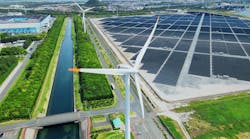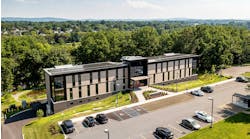A Beginner’s Guide to Building-to-Grid Technology
Traditional buildings consume a significant amount of energy and often strain the power grid, especially during peak hours. This not only leads to high energy costs but also puts pressure on the grid, leading to potential outages and inefficiencies. But what if buildings could contribute to the stability of the grid and manage energy usage? This is where building-to-grid technology comes into play.
This innovative solution enables buildings to become active participants in the energy ecosystem, allowing them to not only optimize their energy consumption but also direct surplus energy back to the grid. By seamlessly integrating into the grid, building-to-grid technology offers a sustainable and efficient approach to energy management, benefiting both building owners and the larger community.
What Is Building-To-Grid (BtG) Technology?
Building-to-grid technology represents a cutting-edge approach that seamlessly integrates the power grid and building control systems. This integration facilitates synchronized operational decisions, enhancing the performance of both entities concurrently. By fostering coordination between buildings and power grid operators, BtG technology drives higher energy efficiency, empowering buildings to serve as resilient assets capable of absorbing grid shocks.
This innovative framework optimizes energy usage and introduces new services for building owners. BtG technology is a significant step toward creating a more efficient and responsive energy ecosystem. The global building-to-grid technology market is expected to reach a revenue of more than $120 billion by 2030.
What Distinguishes a Building-To-Grid Property?
A building-to-grid (BtG) property is characterized by four primary components:
- Energy efficiency
- Energy storage
- Renewable energy integration
- Load flexibility
Both hardware upgrades and behavioral adjustments play significant roles when it comes to enhancing energy efficiency. Various strategies used for this encompass advanced lighting and HVAC technologies, along with sophisticated building management systems that autonomously regulate energy consumption based on factors such as occupancy, time of day and weather conditions.
Moreover, appliances such as refrigerators and freezers, as well as entire buildings, can undergo pre-cooling measures to tackle peak energy demand during warmer periods. Optimization opportunities extend to water heaters, which can be programmed to operate during off-peak hours, thereby leveraging stored heat energy when necessary.
While the technology for BtG implementation exists, the present challenge resides in interoperability. Despite the availability of smart building control systems for lighting and heating, compatibility issues impede their full functionality.
There exists a crucial necessity for a universal, open protocol for building controls that transcends hardware and manufacturer constraints. Ideally, buildings should incorporate a unified and intelligent system overseeing various aspects, ranging from HVAC and lighting to plug loads, thermal or electric storage, and so on.
How To Foster a Fully Integrated Building-to-Grid Ecosystem?
Building Technologies Office (BTO), a division of the Department of Energy’s Office of Energy Efficiency and Renewable Energy, is actively pursuing integrating transactive energy and transaction-based controls within its research initiatives. This strategic focus aims to alleviate the complexities that are currently inhibiting market growth.
Within this approach, several opportunities arise for a fully integrated building-grid ecosystem, such as:
- Transforming buildings into cost-effective storage solutions for the grid, capable of seamlessly balancing peak and off-peak demand fluctuations through automated processes
- Empowering building owners, operators and tenants with access to previously untapped energy markets, thereby creating new revenue streams from energy savings, efficiency improvements and enhanced insights into energy consumption
- Facilitating the entry of new participants into emerging markets, fostering economic development, creating new jobs and establishing domestic technological leadership are critical for global competitiveness and energy independence
How Does Digitalization Contribute to Energy Efficiency and Cost Reduction?
Digitalization in buildings, coupled with efficient data management, offers unparalleled benefits for energy consumers and is facilitating a prominent transformation in the construction sector. With the rapid advancement of intelligent infrastructure and Internet of Things (IoT) technologies, building digitalization optimizes energy usage and lowers construction expenses. Moreover, it offers flexibility to the grid through various mechanisms such as demand response (DR), energy storage, microgrids and participation in electricity markets.
The Buildings Performance Institute Europe (BPIE) highlights the immense energy-saving potential of flexible energy management, estimating up to 500 billion euros in Europe alone. Additionally, regional and country-level policies serve as catalysts for the digitalization of energy and buildings. For instance, Europe established ambitious climate and energy goals, including targets such as 20% renewable energy in final consumption in 2020.
Benefits of Building-to-Grid Technology
The advantages of a fully integrated BtG ecosystem are extensive, offering numerous benefits such as:
- Buildings serve as efficient and cost-effective storage solutions for the grid, seamlessly balancing demand fluctuations through automated processes
- Building owners, operators and tenants gain access to previously inaccessible energy markets, unlocking additional revenue streams from energy savings, trading activities, efficiency improvements and enhanced insights into energy consumption patterns
- The emergence of new markets encourages participation from a diverse range of stakeholders, stimulating economic growth, creating new job opportunities domestically and establishing the nation as a leader in technological innovation, strengthening global competitiveness and reinforces energy independence
What Are the Challenges Associated with Building-to-Grid Technology?
Implementing a building-to-grid (BtG) system presents multifaceted challenges encompassing physical, policy/regulation, economic and social factors. One significant hurdle in the pre-design phase is the setting of appropriate goals for each building’s requirements, including demand response, renewable energy integration, energy efficiency and carbon emission reduction objectives. Assessing the current capabilities of the building, such as existing Energy Management and Control Systems (EMCS), is essential to determining improvement goals, with more sophisticated technology offering enhanced energy management and demand response capabilities.
Integrating existing equipment poses another challenge, especially for older buildings, requiring careful planning to ensure compatibility within the BtG framework. Despite these challenges, navigating through each phase with a clear understanding of project goals and leveraging advanced technology can lead to effective energy management and demand response strategies, thereby contributing to a more sustainable and resilient built environment.
Winding Up
The emergence of building-to-grid technology signifies a transformative solution with the potential to enhance energy efficiency, mitigate emissions, and optimize building and grid performance. Integrating buildings with the electricity grid offers opportunities to alleviate grid strain, decrease pollution and strengthen the economy. Through coordinated actions between the power grid and building controls, BtG technology conserves energy, enhances grid reliability and promotes cost savings, improved resource utilization and a sustainable energy landscape.


